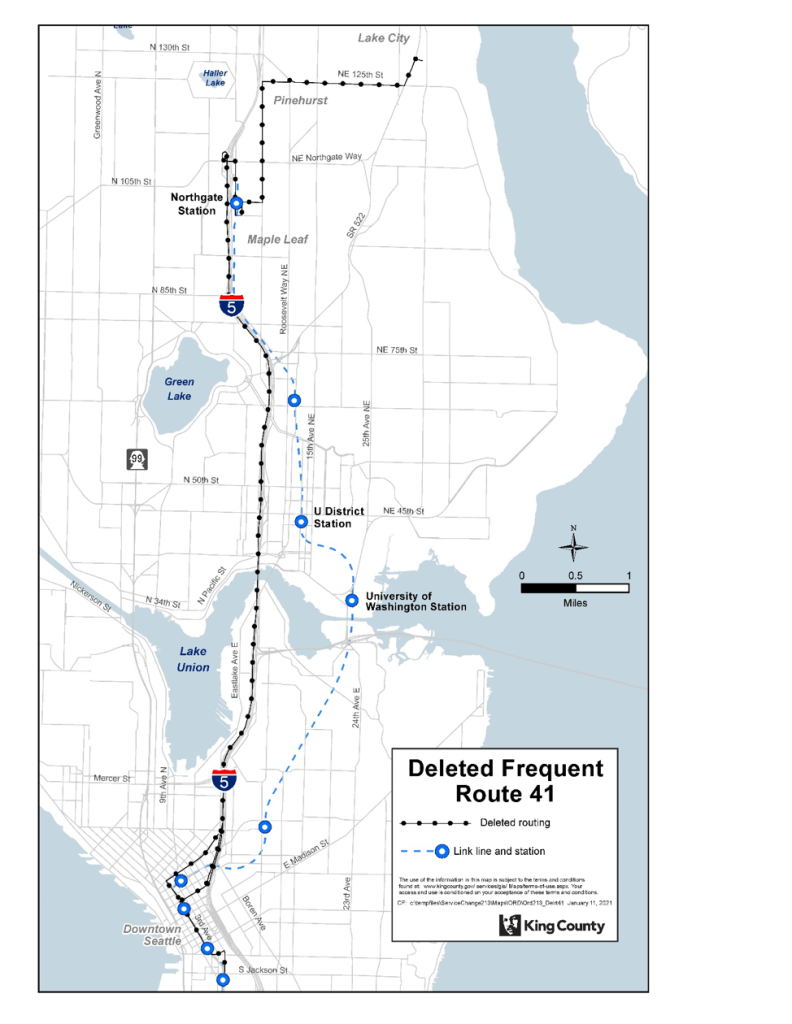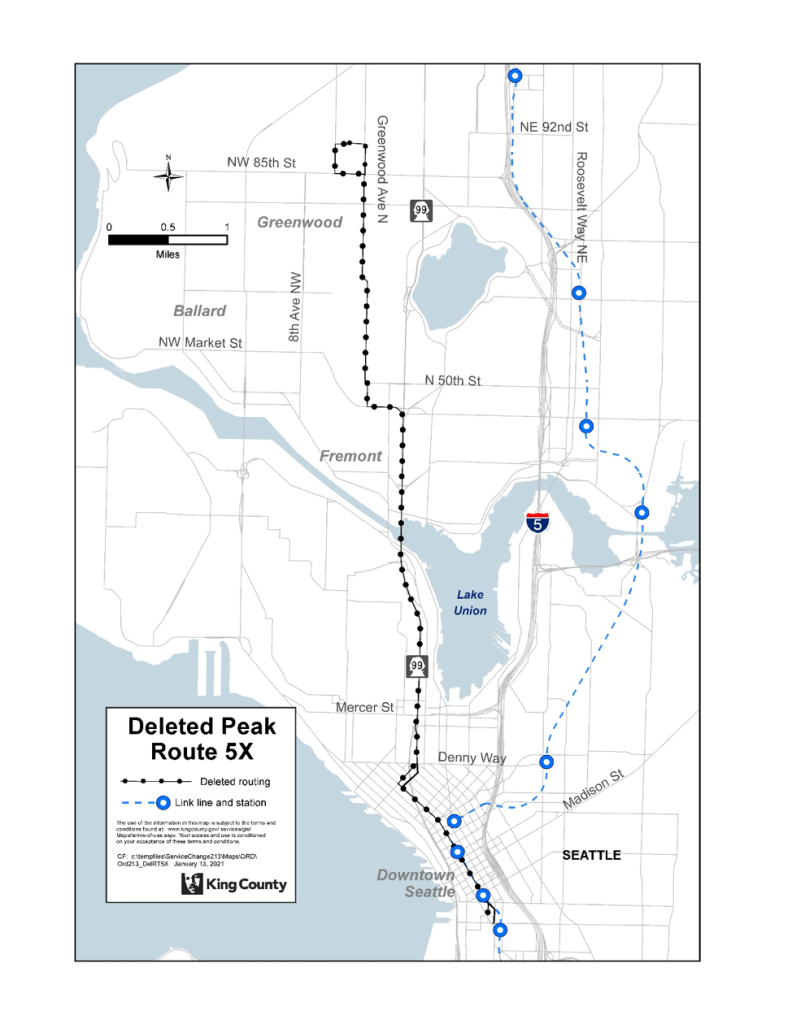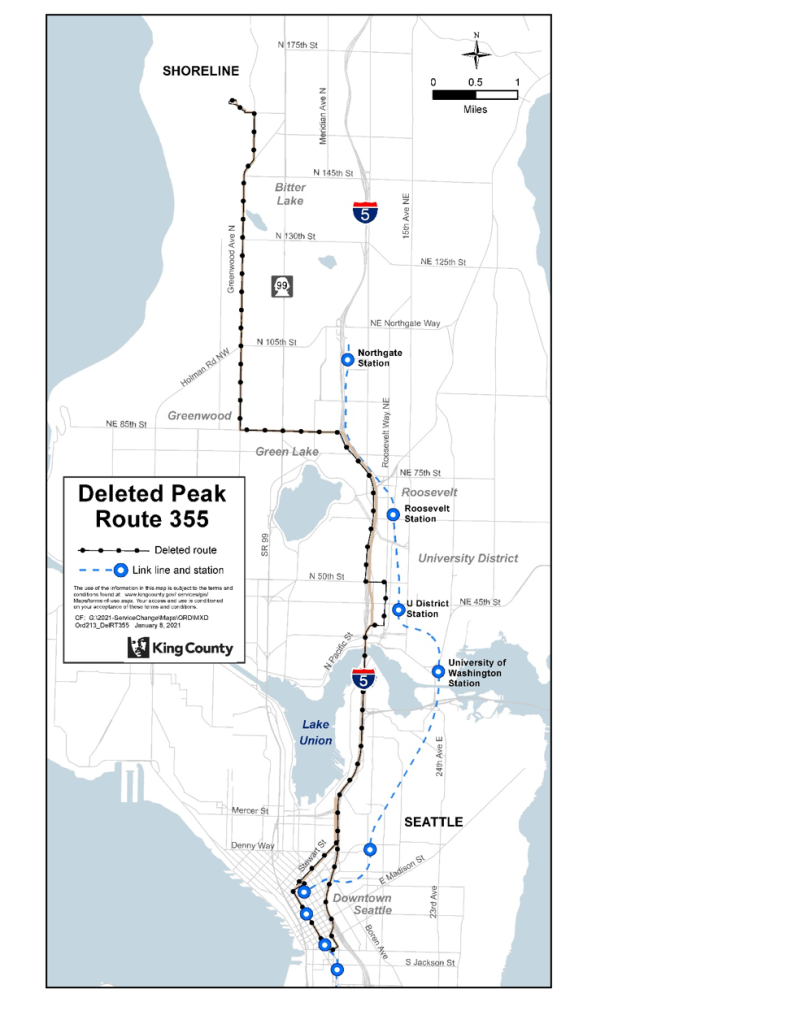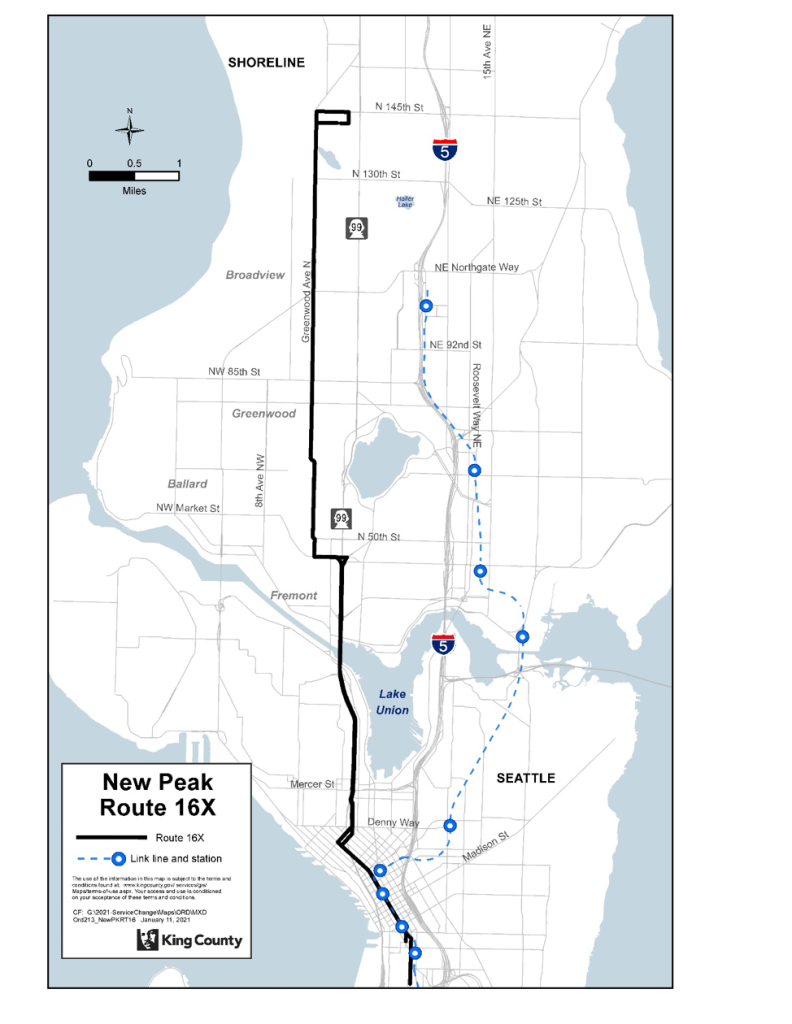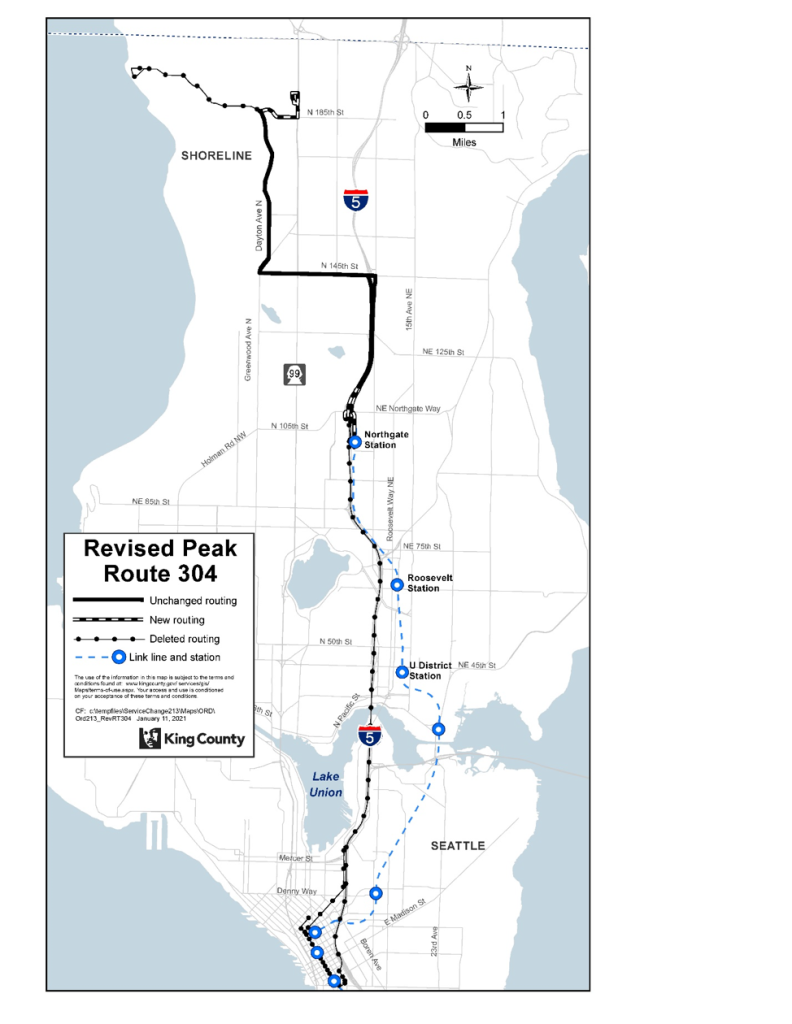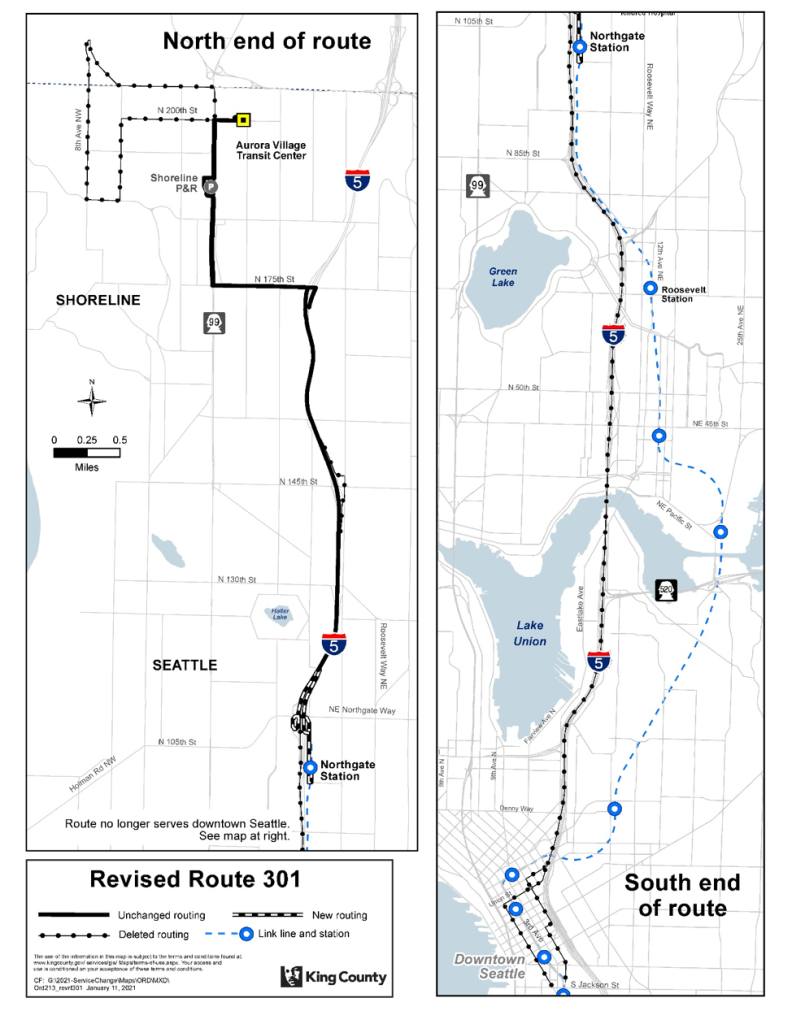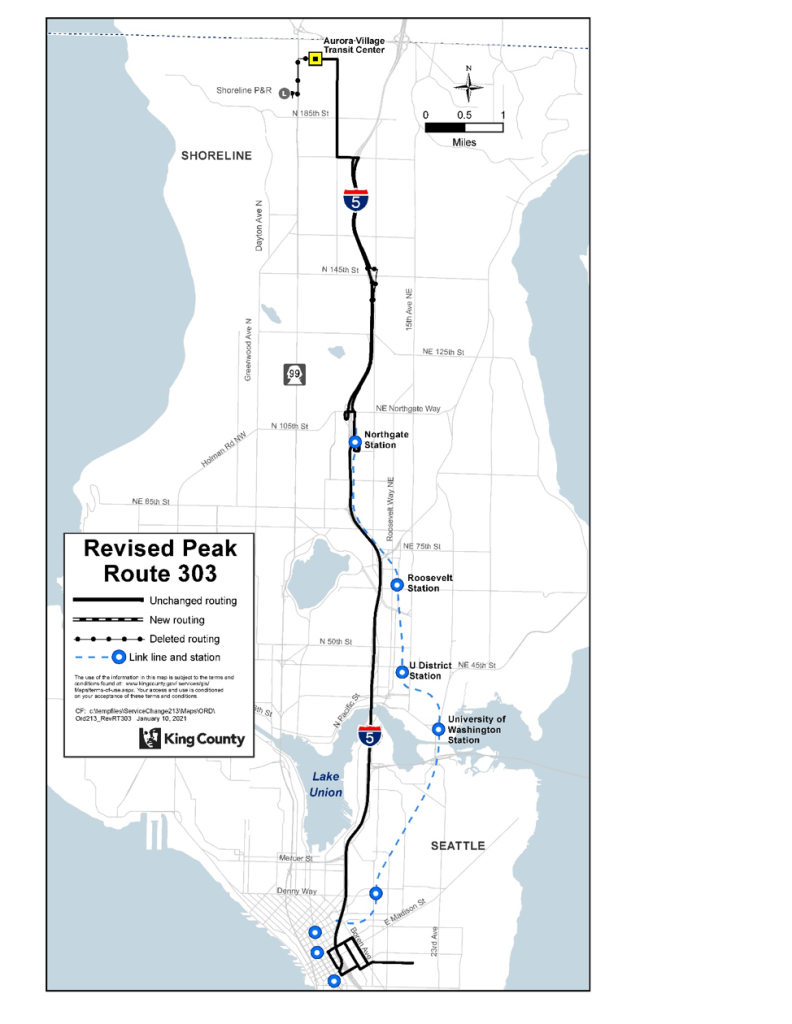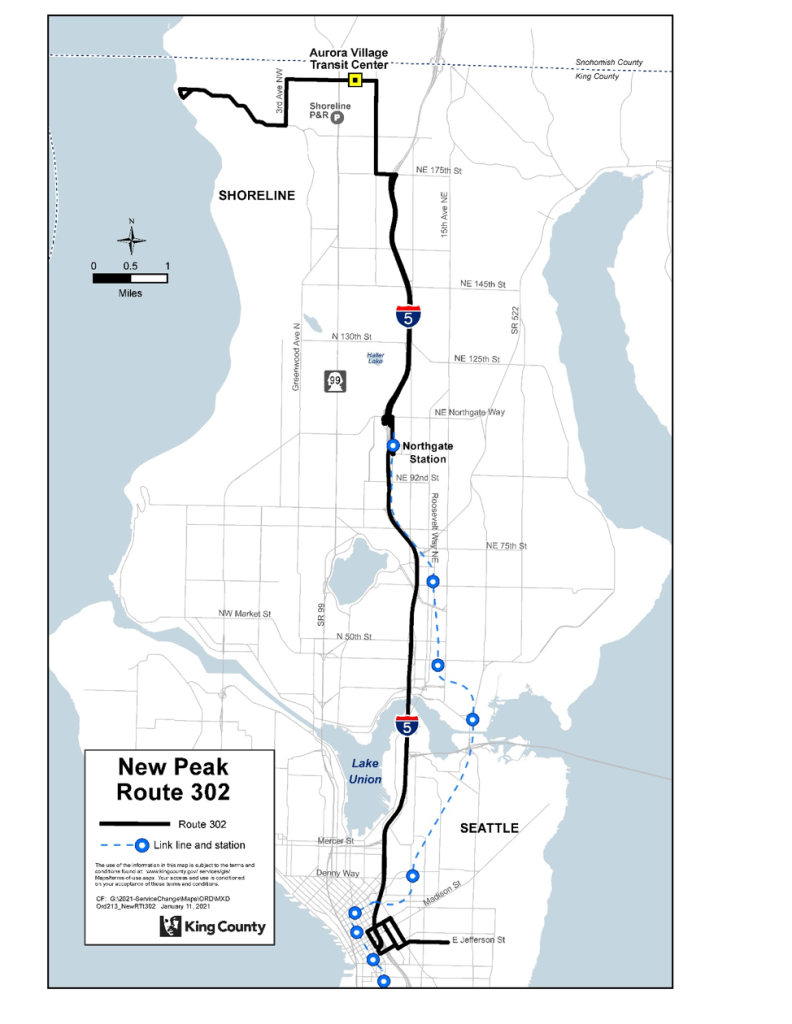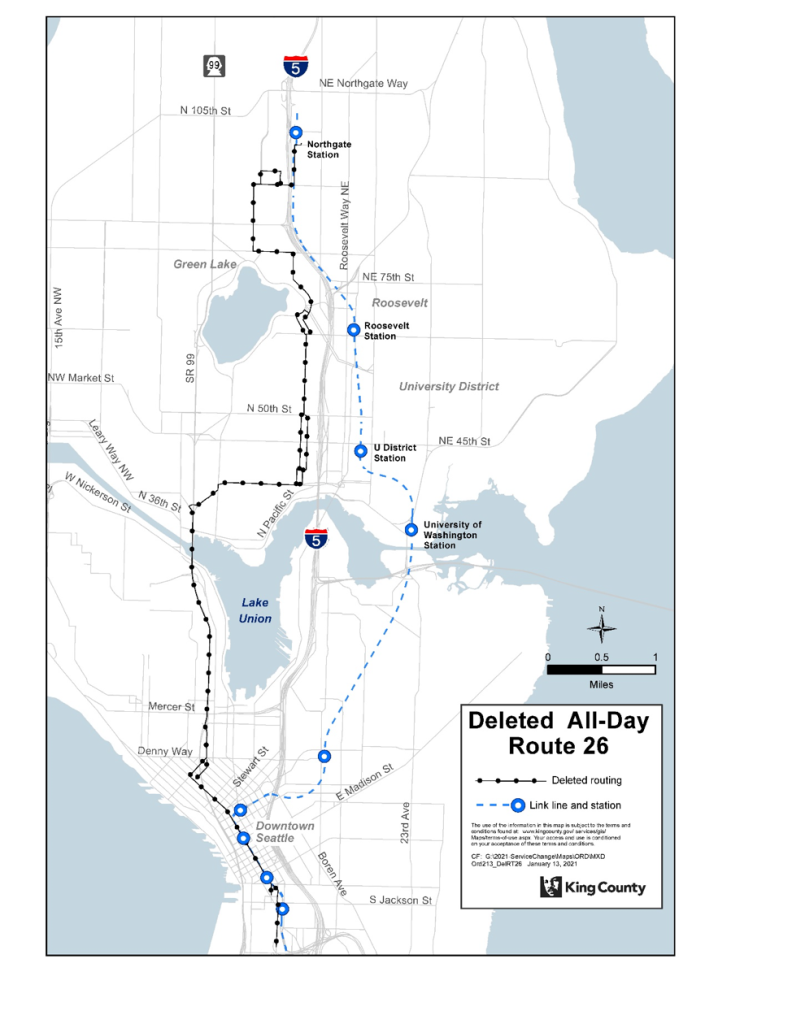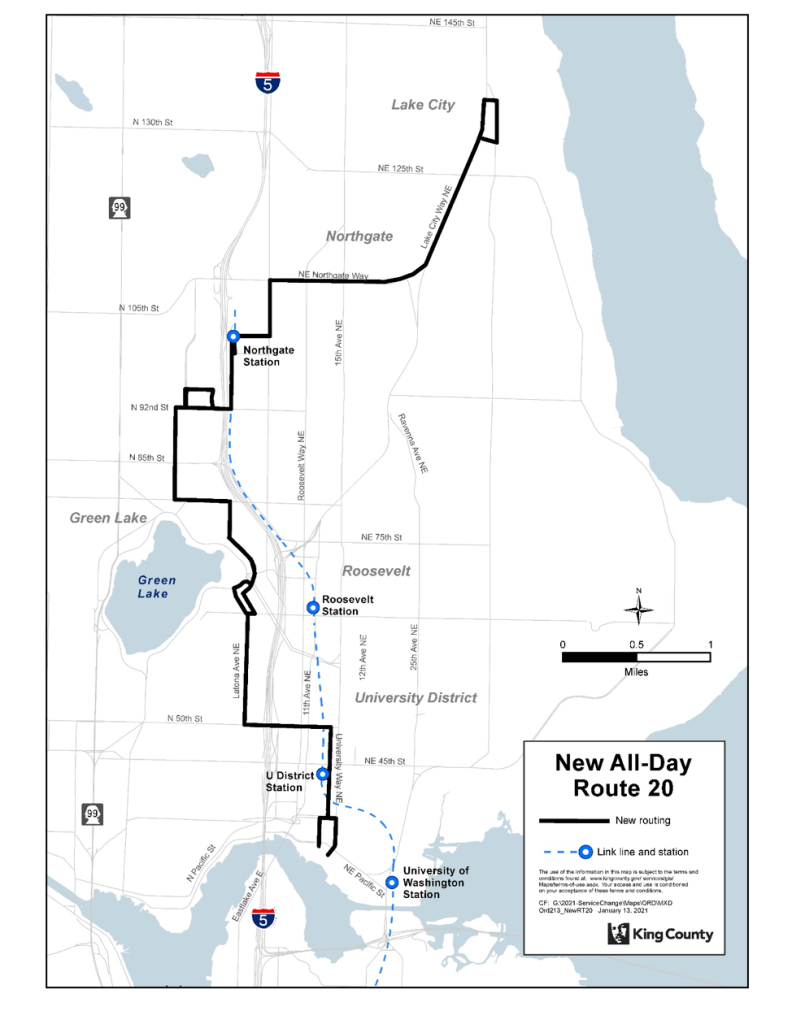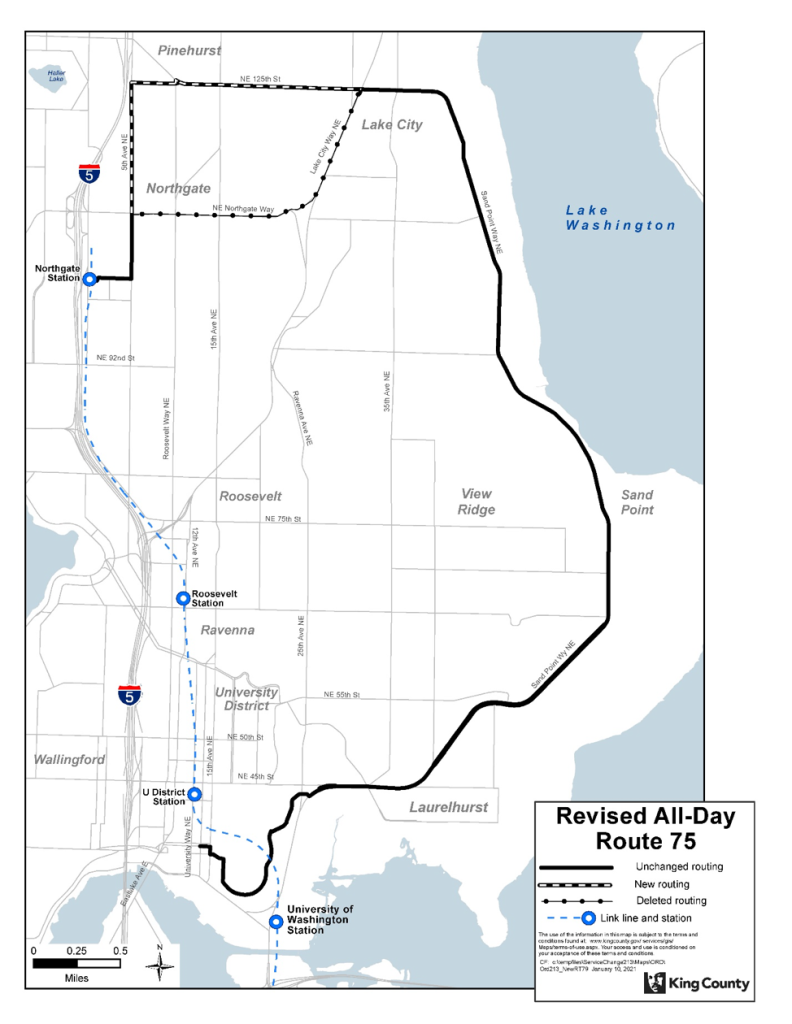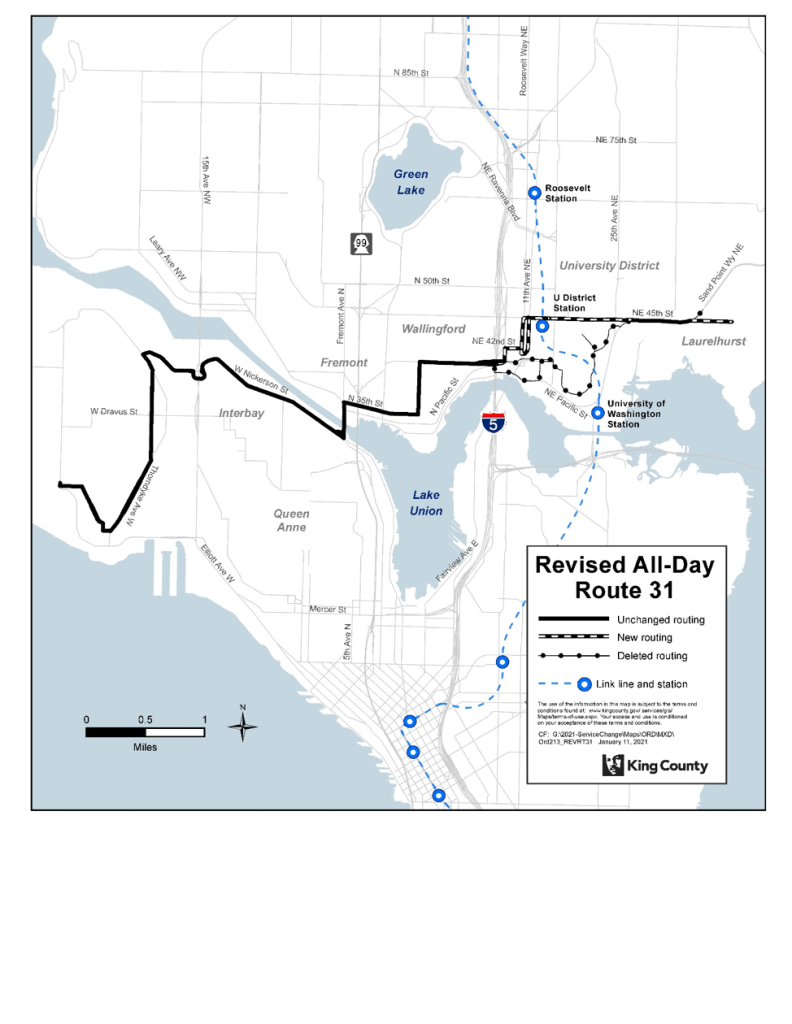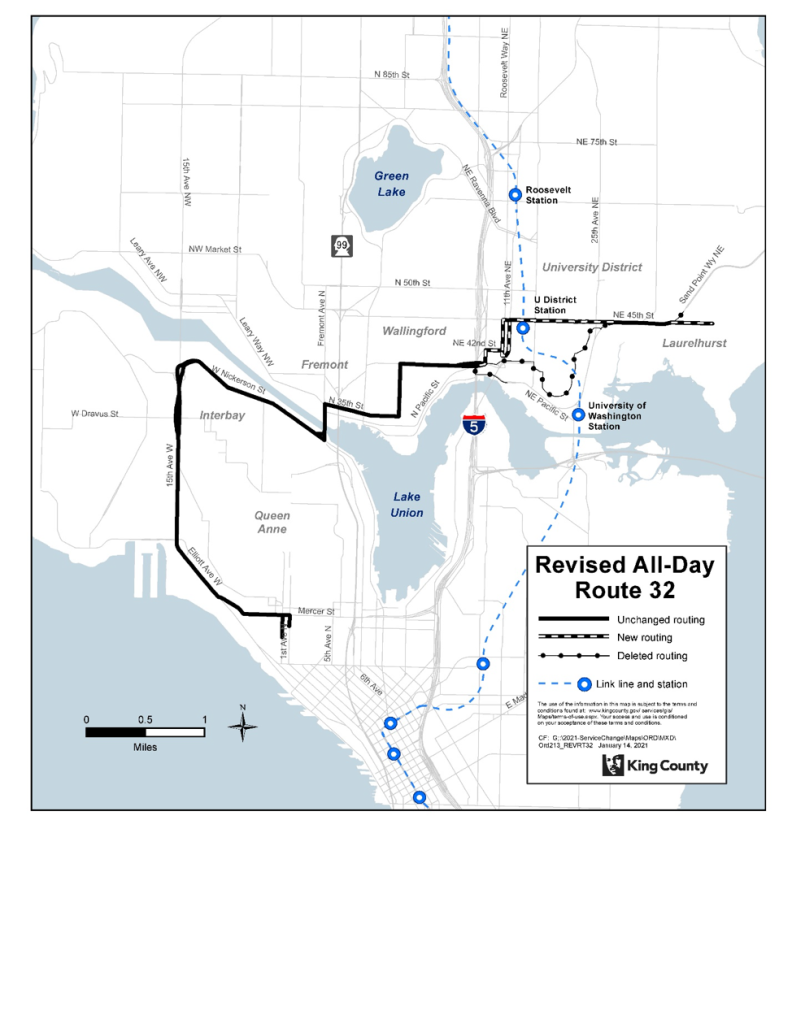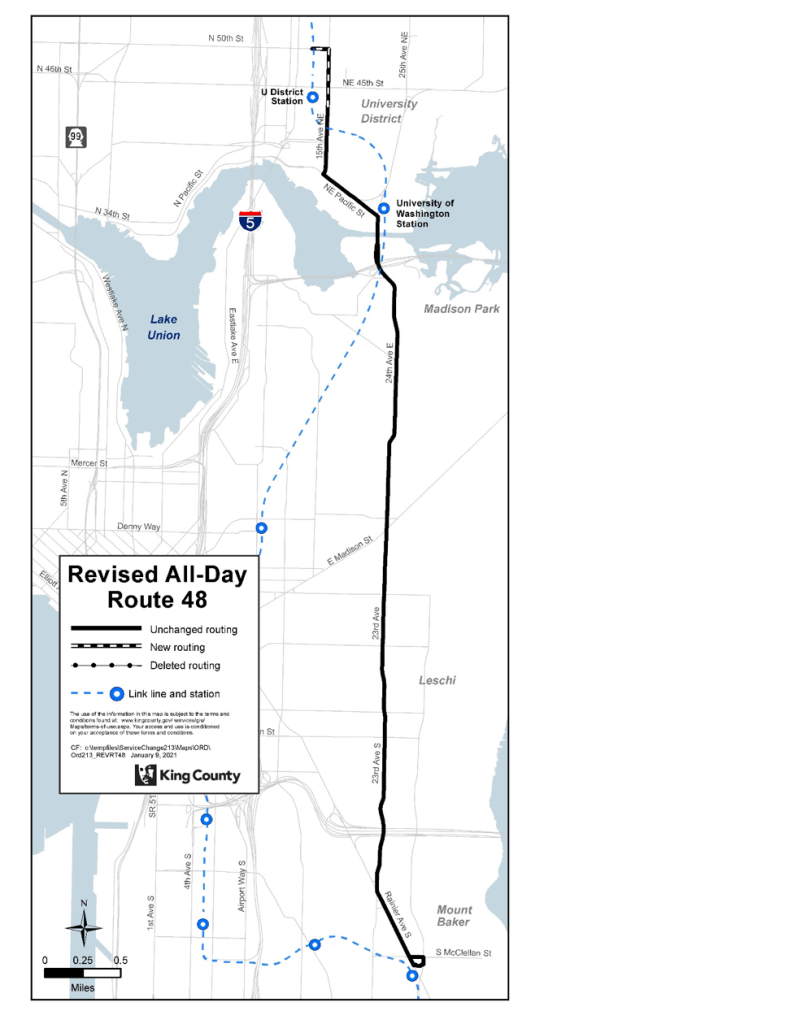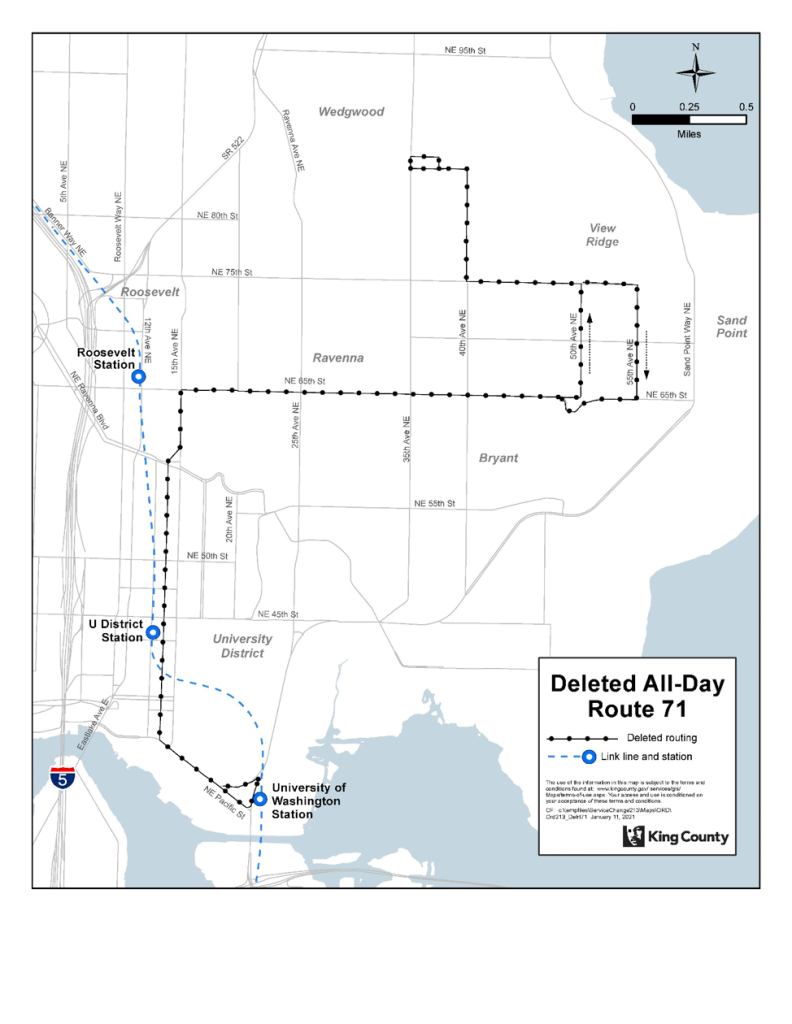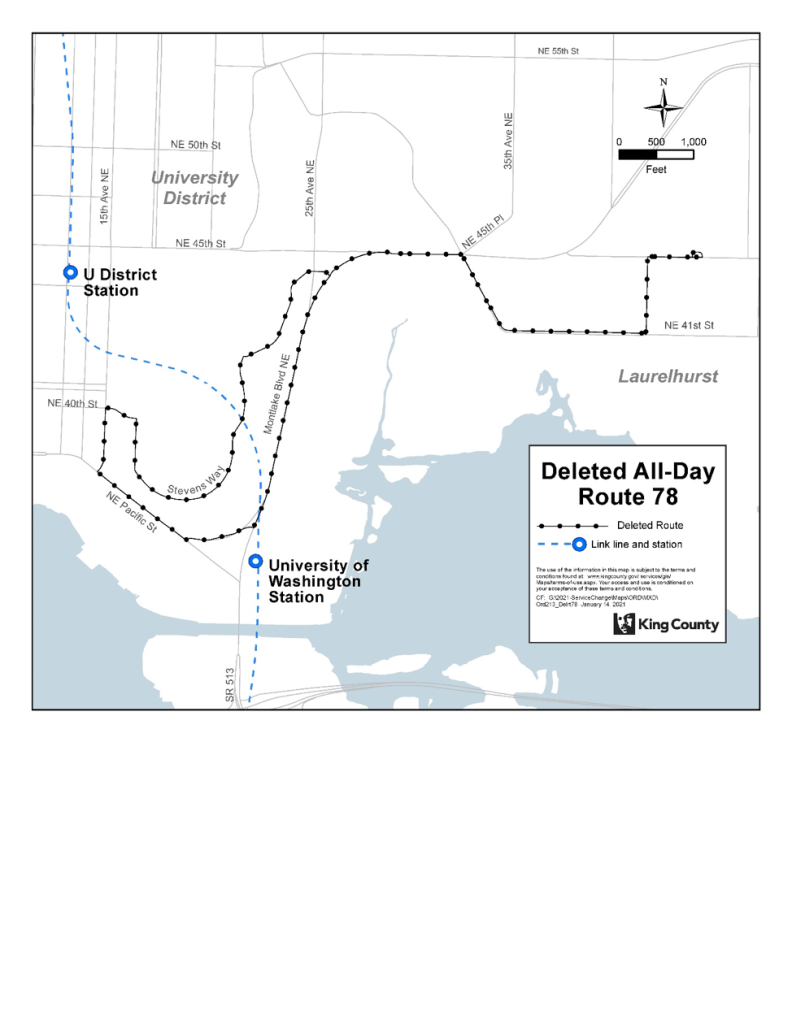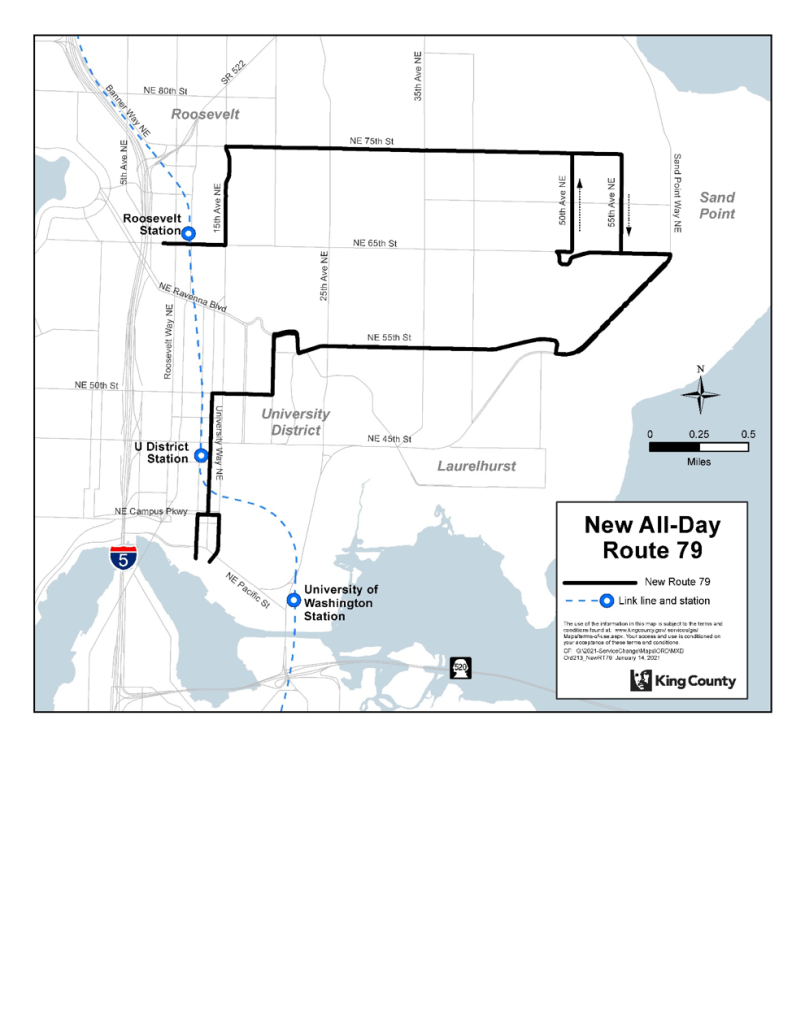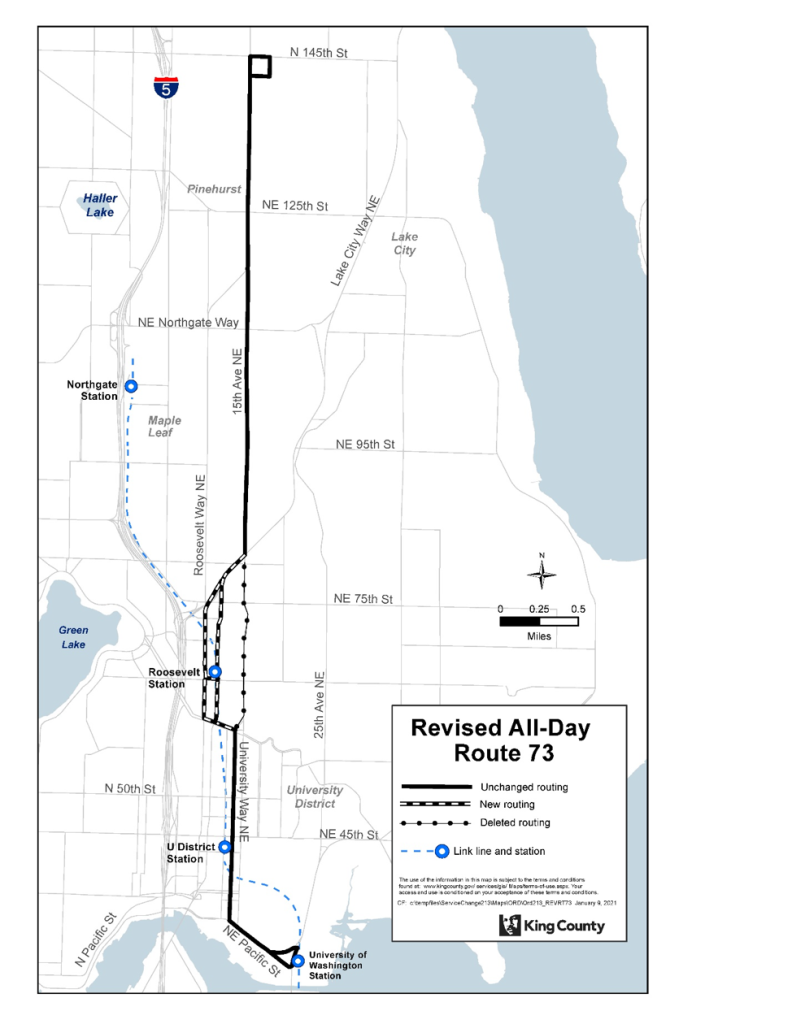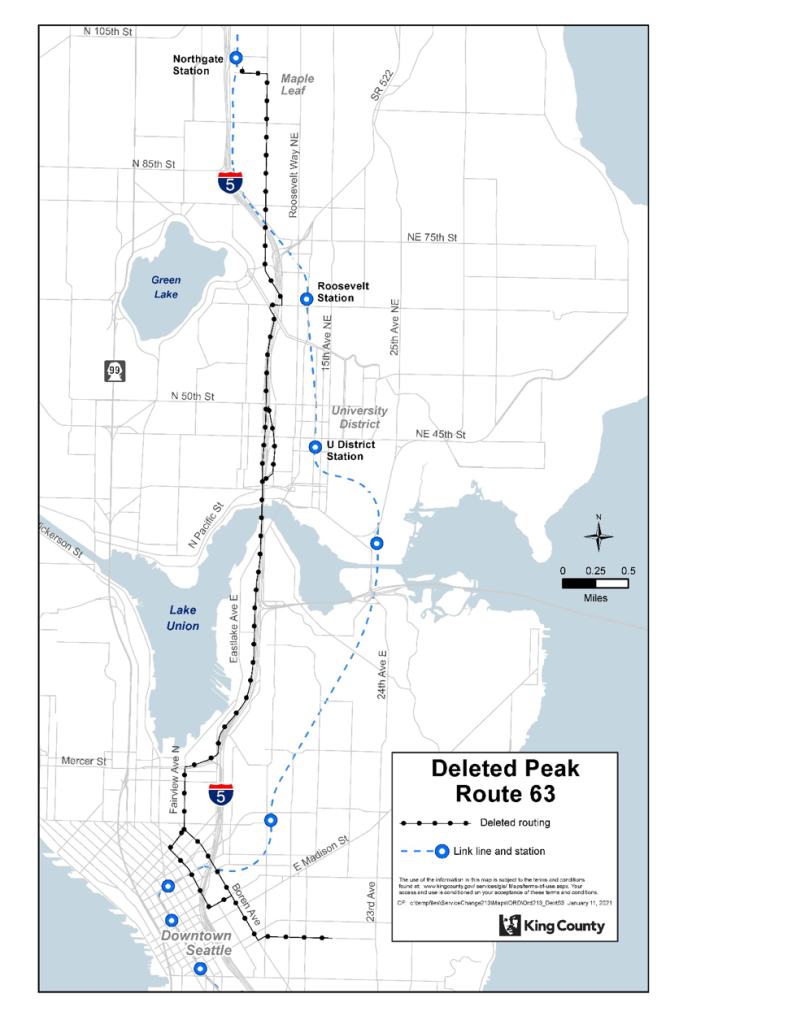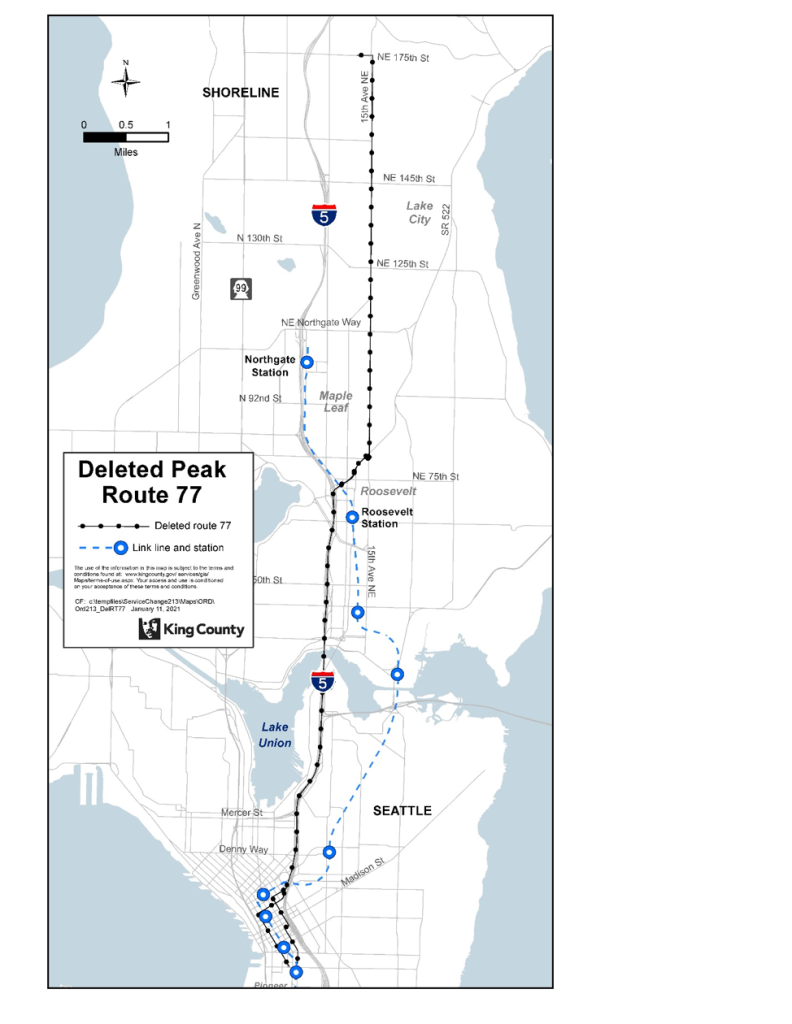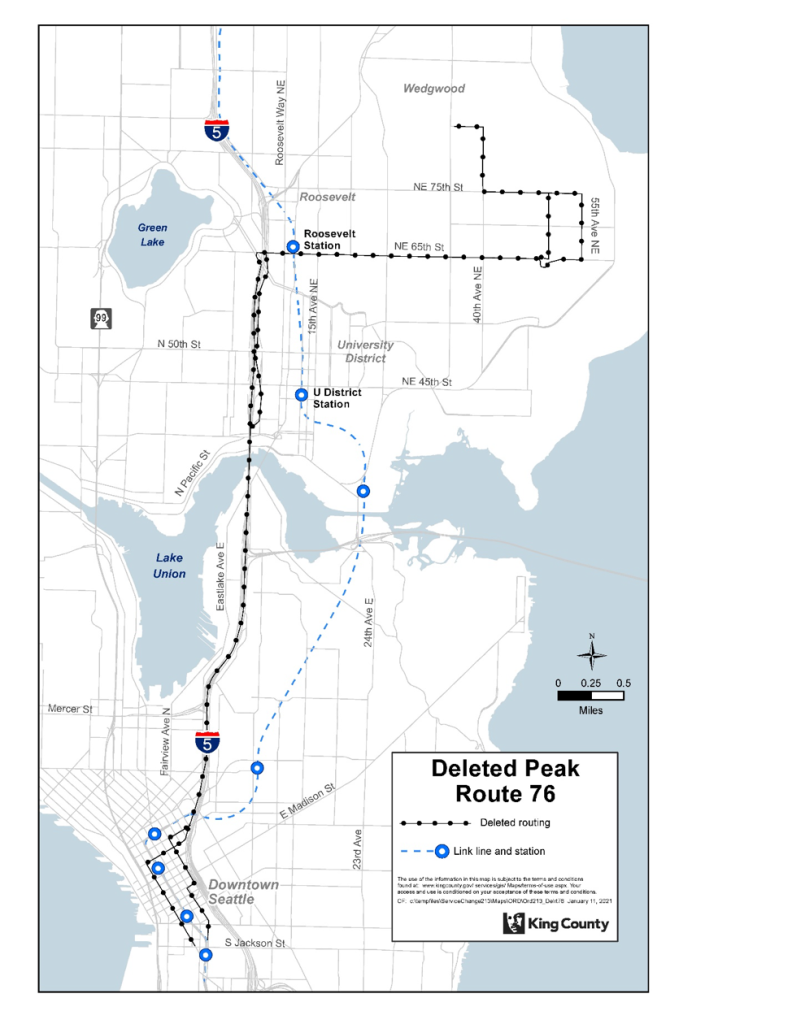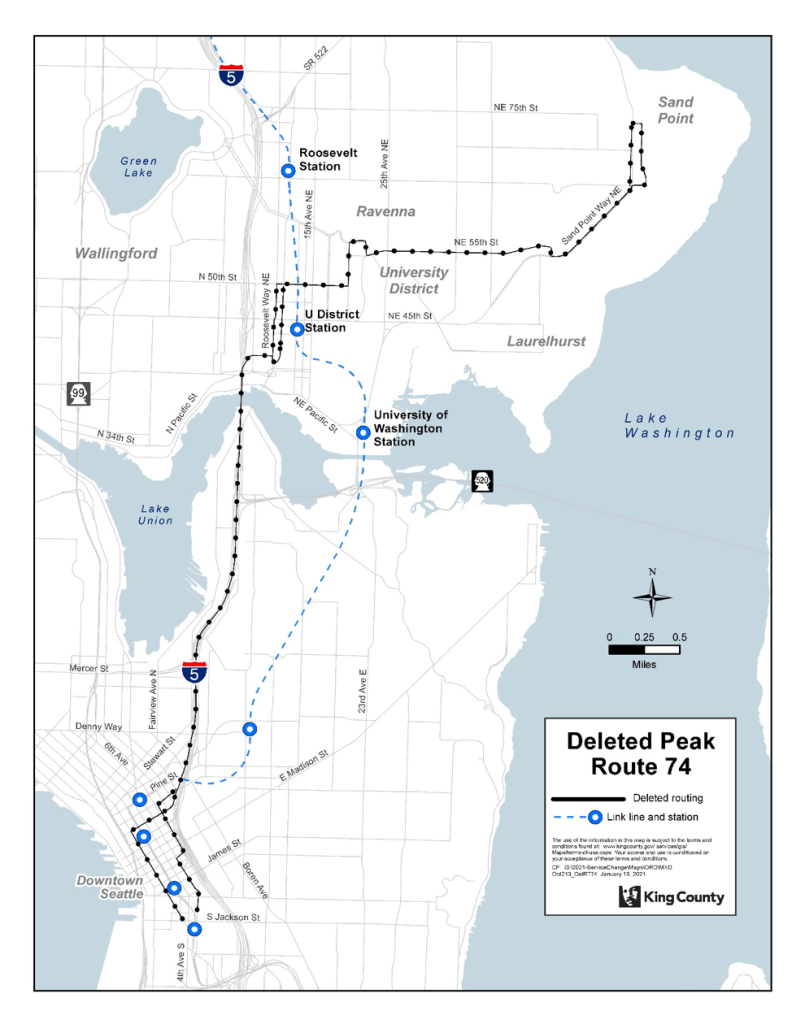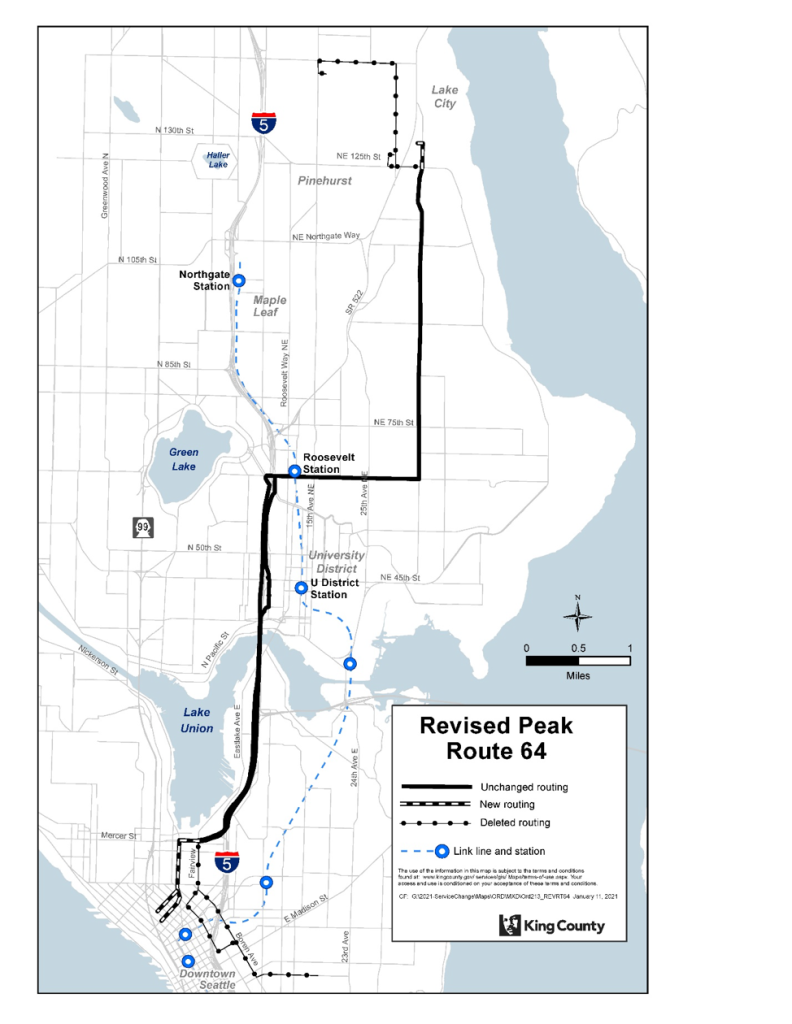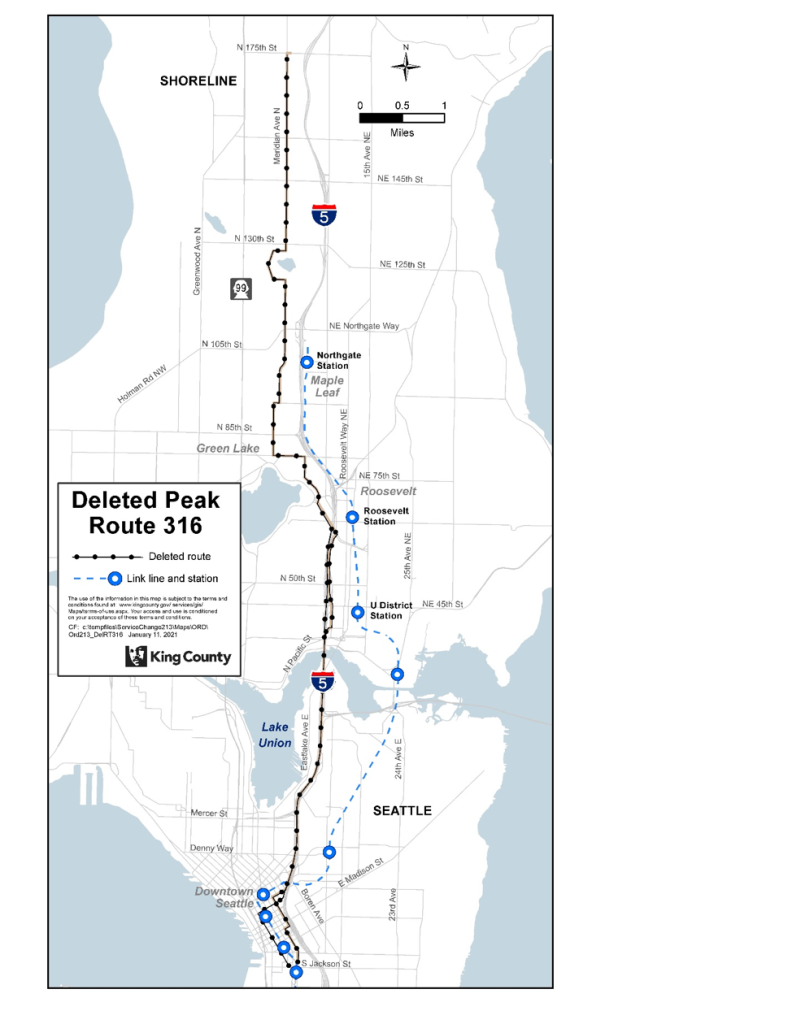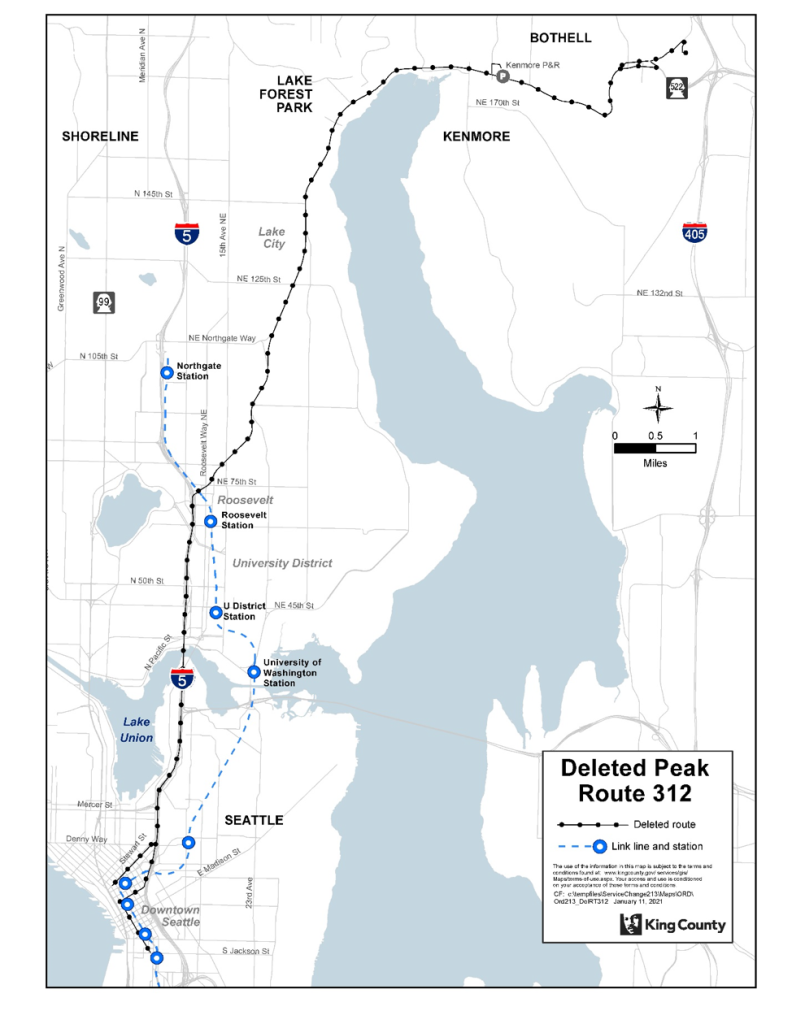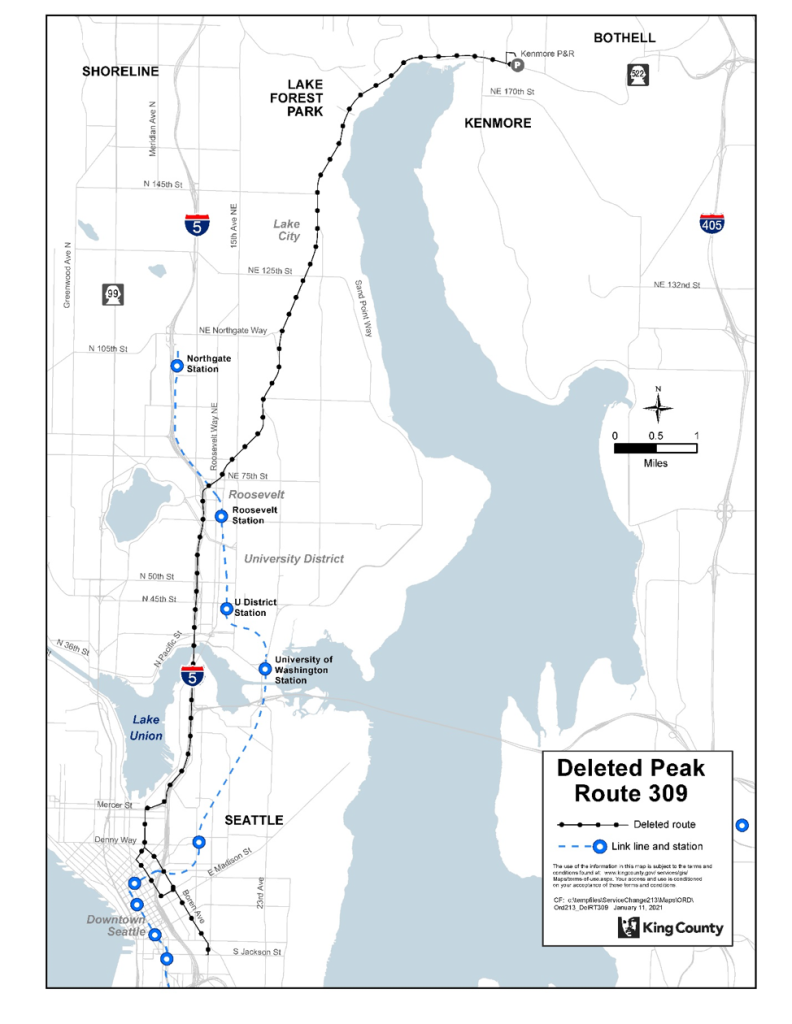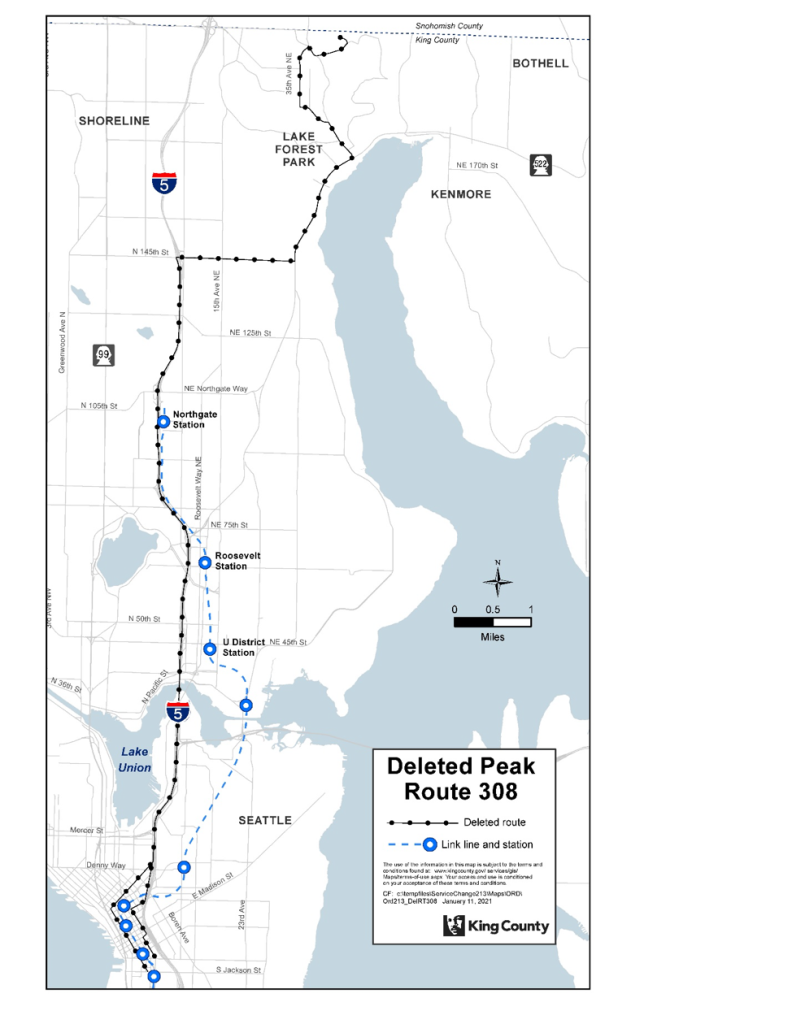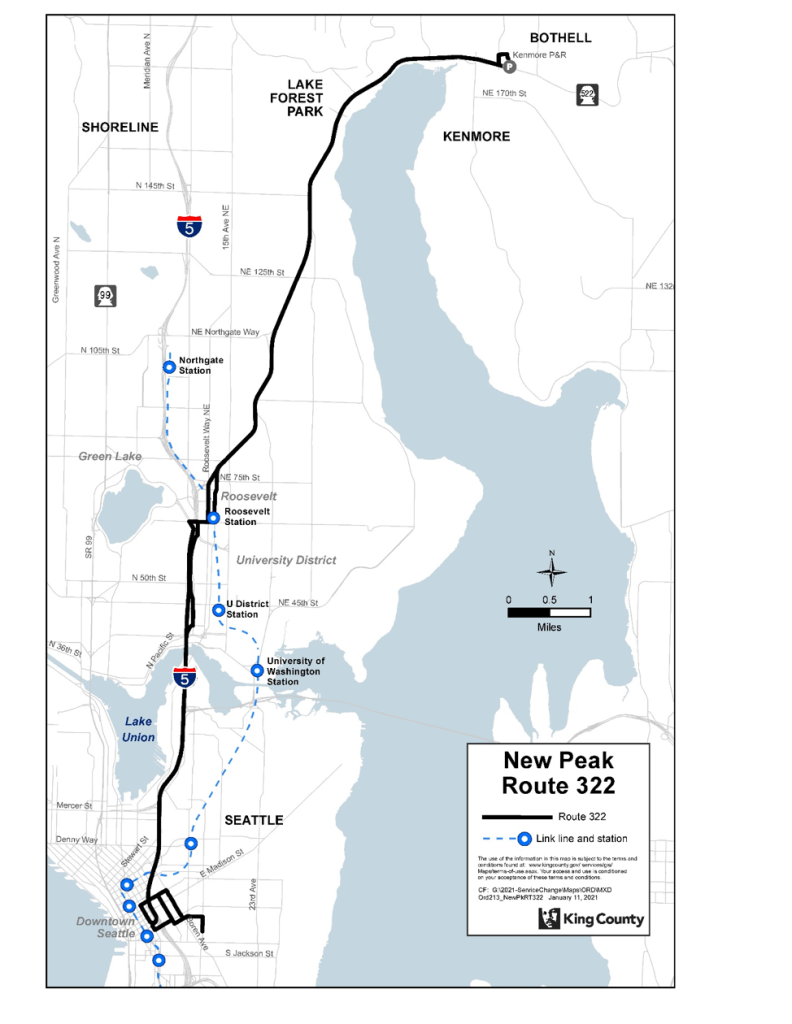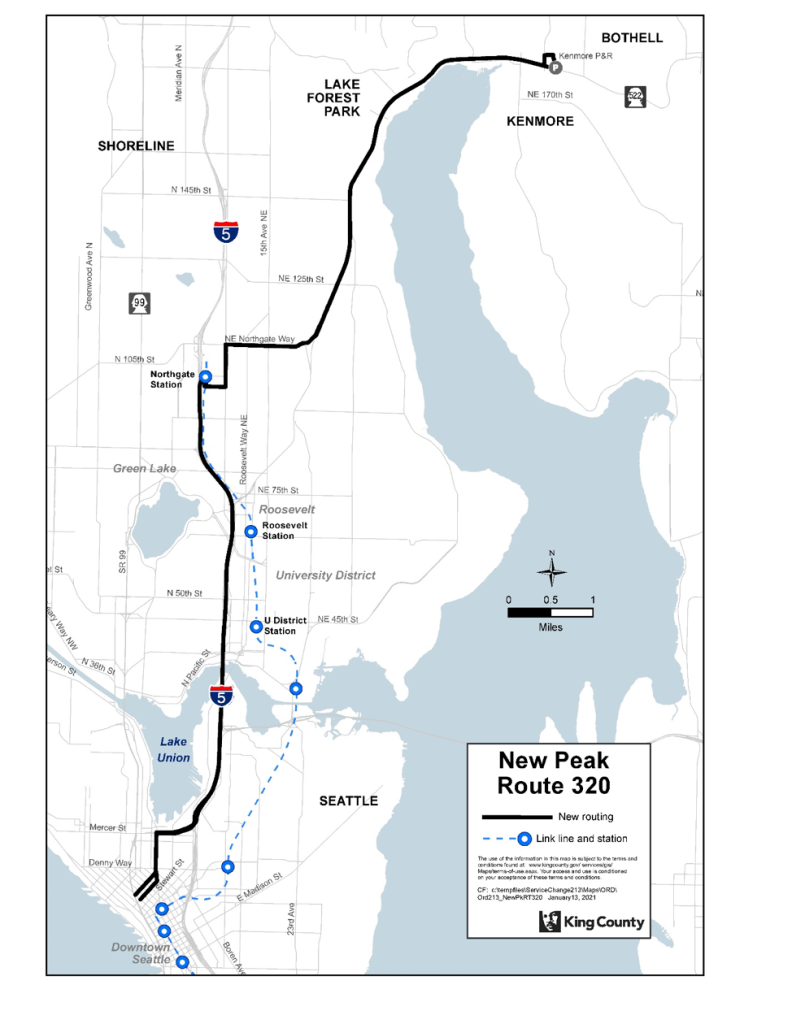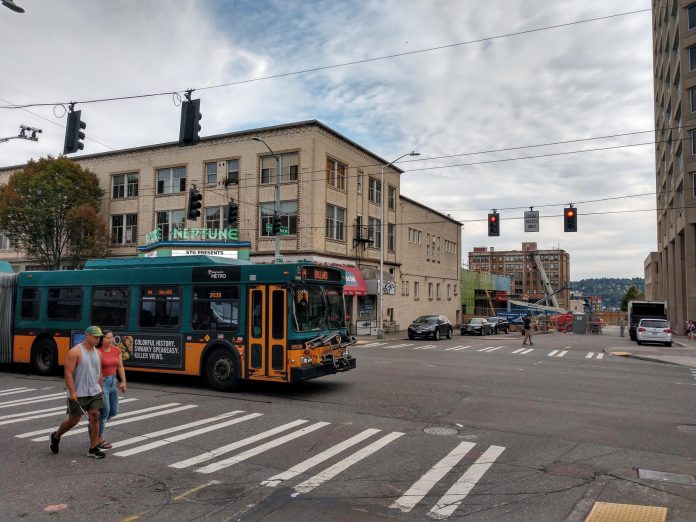
Major changes to bus routes focused in North Seattle and other North End areas are coming in the fall to coincide with the opening of the Northgate Link extension. Over 20 existing King County Metro routes are affected by the changes, which means a big shakeup to local and commuter service as many routes are fed toward the new Link light rail stations. In some cases, routes are being consolidated and deleted in favor of light rail.
Approved in early May by the King County Council, the bus restructure will go into effect on October 2nd instead of around the usual fall equinox service change time. Metro will delete 14 routes, create 7 new routes, and revise a further 10 routes.
The adopted changes are similar to the draft plan we shared last year. But it falls far short of the bolder cross-town bus service concepts that had kicked off the process and for which North Seattleites have yearned for decades. The process feels oddly reminiscent of the broken U-Link bus connections restructure process from 2015 that forsake big ideas and the failed SR-520 bus restructure process from 2017 that never came to be. Our earlier report panned last fall’s proposal as a devolution into pandemic-induced austerity cuts, but Metro cast the changes as just a normal consequence of process: “Metro adjusted and refined its proposed network changes as part of the network refinement process as is normally the case prior to submittal of the final proposal to council following analyses, discussions with partner agencies, and extremely robust public engagement.”
Perhaps it is, but it’s still a hard-to-love outcome for riders.
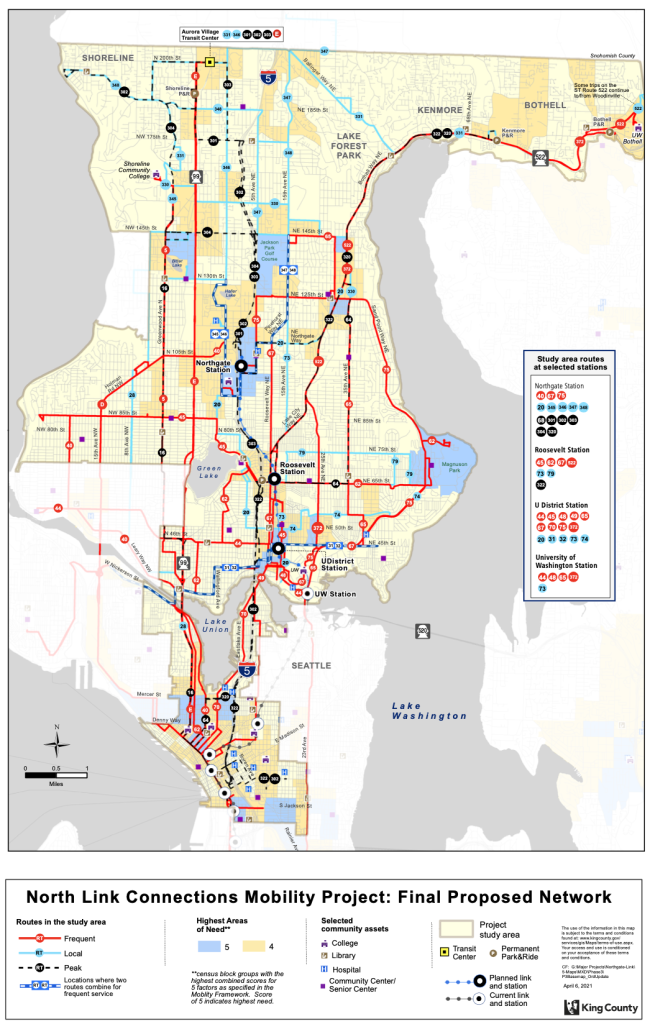
One area of Metro’s proposal that has been controversial is the redeployment of 47,000 annual service hours from the North End toward other areas, particularly Southeast King County, where ridership has stayed steadier during the pandemic. Most of these annual service hours are coming from the deletion of Route 41. Metro sees Route 41 as almost entirely duplicative of the Northgate Link extension between Northgate and Downtown Seattle and cited its equity framework in shifting service toward the south.
“Metro did not propose redeployment of those hours in the project area because Link light rail will wholly replace it with improved service that is faster, more reliable, and able to carry many more people than the Route 41 it replaces,” Jeff Switzer said, a Metro spokesperson. “If Metro were to reinvest duplicative Route 41 hours into the project area, it would be a significant increase in service operating in the area over pre-pandemic levels. Given resource limitations and increasing demand for service across the county, such a reinvestment would have placed additional investment in the North Link project area ahead of the service needs of the county as a whole (which includes the North Link area).”
King County Councilmember Rod Dembowski, who represents much of the area where routes are being affected, said that he struggled with the proposal. On one hand, light rail stations opening will “bring tremendous capacity” to the restructure area and integrate transit modes. On the other hand, he worried about the mobility and equity standpoints of the proposal.
“We have a partner in the City of Seattle in serving this area and unfortunately their revenue and [transit funding district] is down and they are reprioritizing what revenue that they do have to provide other service,” Dembowski said. “That mean they’re taking out as we open light rail about 125,000 [annual] service hours — maybe more. And we’ve been very fortunate up in the North End to have built this beautiful … all-day frequent transit network in the last few years and it’s the model transit network in my view and so it’s sad to see that Seattle service hour commitment be dialed back.”
Dembowski added, “The unfortunate thing and what I’m concerned about with this is we at Metro, we’re taking another 47,000 [annual] hours of service from a part of the 41 that went Downtown out as well; so it’s a significant reduction in the 170,000 plus hour range. The cost of that 170,000 hours is just over $5 million bucks a year.” He pointed out that the original plan had been “to do more service” as part of the restructure, but the economic woes of the pandemic set in forcing Metro to rethink things. However, revenues have bounced back with Metro seeing the financial picture improved up to $900 million or more, Dembowksi said. He voted against the restructure proposal, being the only county councilmember to do so. Though Councilmember Jeanne Kohl-Welles also was concerned about the lack of east-west connections and the removal of the 47,000 annual service hours.
At a recent Regional Transit Committee, Eastside legislators were concerned about the precedent this policy might set in their neck of the woods when the East Link opens in 2023. Despite duplicate services, Metro has suggested that impacts would be minimal.
Changes by area
Northwest
In Northeast Seattle and Shoreline, Metro is simplifying its express route options. Thinking of Route 5X and 355 as a pair, Metro plans to consolidate them into a new Route 16X running along Greenwood Ave N from N 145th St to Downtown Seattle. Many of these riders are likely to find service to the University District and Downtown Seattle faster via bus connections to light rail, making express bus service less useful and in-demand.
Another pair of routes from Shoreline are planned for revision and consolidation. Route 304 will no longer service Richmond Beach or Downtown Seattle. Instead, it will run from western Shoreline to Northgate Station as a peak-hour express and see a small increase in the number of tips. Route 301 will essentially do the same from Aurora Village Transit Center via Aurora Avenue, N 175th St, and I-5. It will also benefit by a large increase in peak-hour trips. Route 303 will only get modest routing changes, trimming it up slightly, and a small reduction in the number of trips. And a new peak-hour express Route 302 will run from Richmond Beach via Aurora Village Transit Center to Northgate Station and then to First Hill with four trips in both the morning and afternoon. Riders in Shoreline will still be able to choose from a constellation of local all-day services like Routes 330, 331, 345, 346, 347, and 348.
Central
The big idea for the central restructure area is a new all-day Route 20 that would operate from Lake City to the University District. It will serve Northgate Station and U District Station as well as segments of the current Routes 26 and 75. Metro plans to fully delete Route 26 and revise Route 75 to NE 125th St and 5th Ave NE instead of running on NE Northgate Way and Lake City Way NE, which will leave a gap in Wallingford. Route 20 will operate daily with half-hourly frequencies from early morning to late evenings. Peak-hour service will be as frequent as every 15 minutes. Route 75 will also be adjusted to reduce frequencies across different time periods, but span of service will be slightly extended no weekends.
Another big idea is realignment of Routes 31 and 32 to pass by U District Station and run along NE 45th St to Laurelhurst instead of snaking through the University of Washington campus. This restores service on the heavily trafficked segment of NE 45th St where university students live, giving them better connections to the station and U Village, as well as a more direct bus option for Children’s Hospital workers. As part of this, Metro will delete Route 78, which was an odd all-day milkrun to Laurelhurst. Route 31 will get new Sunday service.
Other changes will involve the deletion of Route 71, an all-day service from View Ridge and Bryant to the University District and University of Washington Station. In its place, Metro is commissioning new all-day Route 79 that will run a slightly different circuit from the University District to Roosevelt via NE 55th St in Bryant, Sand Point Way NE in Sand Point, and NE 75th St in View Ridge. The route will service U District Station and Roosevelt Station, essentially as a station shuttle. Route 73 will be slightly adjusted to deviate from 15th Ave NE to reach Roosevelt Station via Roosevelt Way NE and 12th Ave NE and Route 48 will be slightly extended on 15th Ave NE northward to NE 50th St. Service on Route 48 will get some adjustments with slightly less peak-hour frequencies but higher Sunday frequencies as often as every 15 minutes and Route 73 get new peak-hour service with 15-minute frequencies.
Not changing from the restructure are Routes 5, 28, 40, 44, 49, 45, 62, 65, 67, and 70 as well as the RapidRide D and E Lines.
Central express routes
As for a handful of peak-hour routes to Downtown Seattle and First Hill from the central restructure area, Metro is planning to delete or heavily modify them. Routes 63 (Northgate), 74 (Sand Point), 76 (Wedgwood), 77 (Ridgecrest), and 316 (Meridian Park) will all be deleted. Route 64, for its part, will be revised such that it will serve South Lake Union and Belltown instead of the heart of Downtown Seattle and its northern tail will be trimmed back from NE 145th St to near NE 125th St in Lake City. This route will also benefit from four additional peak-hour trips in both the morning and afternoon.
Northeast
Peak routes serving Lake Forest Park, Kenmore, and Bothell are being trimmed down with the deletion of Routes 308, 309, and 312 and creation of two new services: Routes 320 and 322. Both new routes will run from Kenmore Park-and-Ride along SR-522, but a split happens at NE Northgate Way. Route 320 will continue to Northgate Station and then hop onto I-5 to reach South Lake Union and terminate in Belltown. Route 322 takes a different path, reaching Roosevelt Station and then hopping onto I-5 to head toward First Hill doing a complicated set of switchbacks near the hospitals. The new routes will operate only during weekday peak hours with Route 320 having 15 morning and 16 afternoon trips and Route 322 having 16 morning and 21 afternoon trips.
Outside of these routes, riders will still have the option of using Routes 372 and 522 to reach as far as Bothell and Woodinville. Sound Transit is planning to terminate Route 522 at Roosevelt Station, however, as part of its own bus restructure.
Other changes
A small note in the restructure is that Route 43 will see further service reductions. Peak-hour service will worsen to every 30 minutes, down from every 15 minutes, as the most frequent offering.
Not accounted for in the North Link bus restructure are additive service improvements from the Seattle Transportation Benefit District (STBD). Metro says that the “STBD will be funding approximately 25,000 annual service hours in the North Link project area on Routes 20 (new), 40, 44, 48, 70, 49, 65, and 67.” This partially makes up for some of the lost service hours from the deletion of Route 41 and others that will reduce the annual service hour balance by 47,000 — which could have gone to those routes had they not been reallocated elsewhere in the bus system. But this does beg the question of whether this should be considered supplantation of service hours by the STBD, which Metro is not supposed to do under the funding agreement. Some could see it that way.
Nevertheless, the full suite of changes go forward in October implementing yet another mixed-bag bus restructure. While many of the changes will likely improve things for riders by better connecting them to light rail, many of the big ideas of creating a more coherent and frequent system died which calls into question many of the policies and processes Metro is using to design changes.
Stephen is a professional urban planner in Puget Sound with a passion for sustainable, livable, and diverse cities. He is especially interested in how policies, regulations, and programs can promote positive outcomes for communities. With stints in great cities like Bellingham and Cork, Stephen currently lives in Seattle. He primarily covers land use and transportation issues and has been with The Urbanist since 2014.


